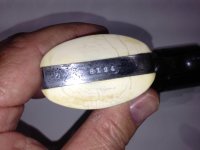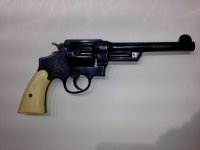u2jimbo
Member
You guys were incredibly friendly, knowledgeable and helpful last year when I inquired about my dad's revolver. You helped me understand and appreciate the historic value of my New Century, Triple Lock, .44 Special as well as the sentimental value of its personal history.
Your interest and support led me to try to take greater care of this weapon. I enthusiastically purchased an SKB waterproof gun case, cut out the gun silhouette in the foam, added space for some rounds, thoroughly cleaned and oiled the revolver, covered it with the second layer of foam, placed the gun's holster on top of that foam and closed the lid.
I checked on it from time to time - all was well. I was proud.
I opened the gun case two days ago and found the revolver covered in rust. Not the kind of rust that looks and feels like a smooth smear of brown on a steel carving knife but 3-dimensional hillocks of rust that felt sharp and tough. They did not yield to smearing finger pressure or fingernail picking. These rocky rust islands were in many discreet locations all over the gun.
The cylinder had rust on the outside but not inside the ammo tubes (sorry, don't know the correct nomenclature); on the barrel, but not in the bore; many spots on the frame. Even the backside surfaces of the two ivory grips had rust on the edges that rest on the steel frame (and now, are apparently permanently stained).
I removed the cylinder and the cover plate worried there would be rust on all the internal springs, levers, and slides and axels but they were all OK. At least, regarding functionality, the gun was not compromised. But it looked like C***!
I got out my Hoppe's #9, gun oil, Q-tips, razor blades, 600 grit wet or dry sandpaper, and my dads Herters needle file assortment and went to work.
Very tough rust! I spent an entire day working this stuff off the gun. While doing that, I tried to work through what the underlying cause of the rust was...I believe it was the holster.
I had been diligent about IT, too. It was all dried out and stiff, so I got out the Lexol and gave the holster a deep cleaning and moisturizing treatment. When I stored it on the foam on top of the gun it never occurred to me I was putting a 'water bomb' in the sealed container with my pistol! Unbelievable! I really amaze myself, sometimes.
In any case, the rust is gone. Unfortunately, the blued finish is now in substantially worse condition than before.
I have two questions for you all:
1. Now what? Should I just leave well enough alone and rack this up to experience - letting the gun record this as additional history; or should I seek out a gunsmith to re-blue the gun (I emailed S&W to see if they provide such services), or?
I doubt that I will ever sell the gun, so preserving the historic value from a collectors perspective isn't striking me as particularly important; and subconsciously, I probably want to erase the evidence of my mistake. But, what action is in the gun's best interest?
2. What are the safe and sane methods of storing a weapon? (is the SKB case overkill because its sealed?)
Thanks again!
Jim Simpson
Your interest and support led me to try to take greater care of this weapon. I enthusiastically purchased an SKB waterproof gun case, cut out the gun silhouette in the foam, added space for some rounds, thoroughly cleaned and oiled the revolver, covered it with the second layer of foam, placed the gun's holster on top of that foam and closed the lid.
I checked on it from time to time - all was well. I was proud.
I opened the gun case two days ago and found the revolver covered in rust. Not the kind of rust that looks and feels like a smooth smear of brown on a steel carving knife but 3-dimensional hillocks of rust that felt sharp and tough. They did not yield to smearing finger pressure or fingernail picking. These rocky rust islands were in many discreet locations all over the gun.
The cylinder had rust on the outside but not inside the ammo tubes (sorry, don't know the correct nomenclature); on the barrel, but not in the bore; many spots on the frame. Even the backside surfaces of the two ivory grips had rust on the edges that rest on the steel frame (and now, are apparently permanently stained).
I removed the cylinder and the cover plate worried there would be rust on all the internal springs, levers, and slides and axels but they were all OK. At least, regarding functionality, the gun was not compromised. But it looked like C***!
I got out my Hoppe's #9, gun oil, Q-tips, razor blades, 600 grit wet or dry sandpaper, and my dads Herters needle file assortment and went to work.
Very tough rust! I spent an entire day working this stuff off the gun. While doing that, I tried to work through what the underlying cause of the rust was...I believe it was the holster.
I had been diligent about IT, too. It was all dried out and stiff, so I got out the Lexol and gave the holster a deep cleaning and moisturizing treatment. When I stored it on the foam on top of the gun it never occurred to me I was putting a 'water bomb' in the sealed container with my pistol! Unbelievable! I really amaze myself, sometimes.
In any case, the rust is gone. Unfortunately, the blued finish is now in substantially worse condition than before.
I have two questions for you all:
1. Now what? Should I just leave well enough alone and rack this up to experience - letting the gun record this as additional history; or should I seek out a gunsmith to re-blue the gun (I emailed S&W to see if they provide such services), or?
I doubt that I will ever sell the gun, so preserving the historic value from a collectors perspective isn't striking me as particularly important; and subconsciously, I probably want to erase the evidence of my mistake. But, what action is in the gun's best interest?
2. What are the safe and sane methods of storing a weapon? (is the SKB case overkill because its sealed?)
Thanks again!
Jim Simpson


